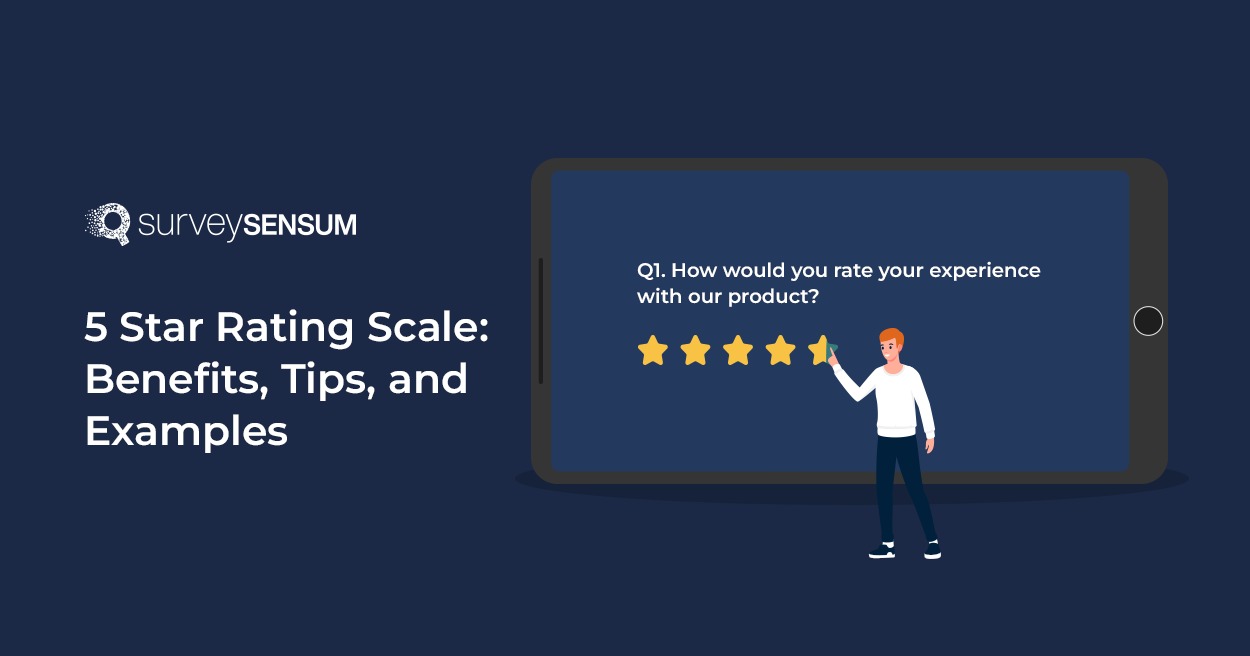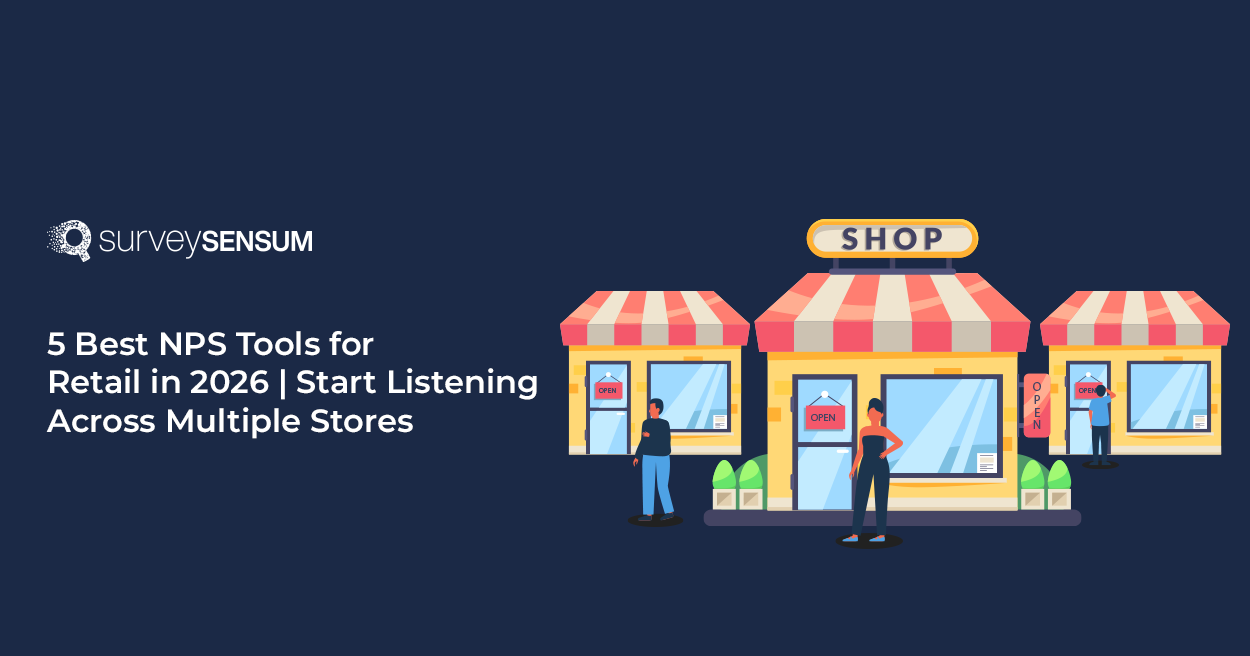

Have you ever left a survey in the middle, overwhelmed by the endless stream of questions? Yes, we have all been there.
It feels like brands want to know every single detail of our experience, but honestly, who has the time for that? That’s where the magic of the 5 star rating scale comes into play to create engaging survey designs! They work best to gather quick and important feedback because they are simple, straightforward, and incredibly effective.
Imagine wrapping up a hair spa appointment at a salon and they give you a CSAT survey and instead of a long and tedious questionnaire, you are asked to rate your satisfaction in stars.
How quick and convenient! This not only minimizes the effort on your part but also encourages more customers to share their opinions. So, let’s talk a bit more about this rating scale, what it is, when it can be used, and explore some examples.
What is a 5 Star Rating Scale?

The 5 star rating scale is a straightforward and simple way of gathering feedback where customers have to rate their satisfaction with stars, on a scale of 1-5. For salon managers fulfilling their duties, this provides an efficient feedback mechanism. Each of these stars represents different labels of satisfaction with 1 star indicating a poor experience and 5 stars indicating an excellent experience.
But, Why Use a 5 Star Rating Scale?
Using 5 star rating scale labels in your survey has some compelling advantages, like:
- Ease of Use: Instead of the traditional questionnaire with an endless stream of questions to answer, 5 star survey provides customers with a straightforward and quick way to provide feedback with only stars.
- High Response Rate: Because it is quick and easy to answer more and more likely to leave a rating and we know that a high response rate means more comprehensive data for businesses to analyze.
- Straightforward Labels: The labels of 5 star rating scale are pretty straightforward and easy to understand. Each star on the scale corresponds to a specific level of satisfaction, with 1 being the lowest and 5 being the highest. This makes it easier for both customers and businesses to provide feedback and analyze it.
Launch CSAT surveys with different question and scale types like multiple choice, Likert scale, 5 star rating scale to create engaging survey designs and boost your survey response rate.
But, when to use this scale in a survey?
When to Use the 5 Star Rating Scale?
Here are some best use cases of the 5 star rating scale.
1. Product Feedback and Reviews
How happy are your customers with the product? Are they satisfied? Well, launch a 5-star rating scale survey to gather product feedback.
Higher the rating, higher the product satisfaction. Customers only need to select the star that best represents their experience. Higher ratings help you identify which aspects of the product are working well and lower ratings help identify areas of improvement, allowing you to pinpoint the root cause of dissatisfaction and prioritize action.
This also helps customers share their positive and negative experiences and product features that meet or didn’t meet their needs and expectations.
2. Website Feedback and Reviews
If you want to understand how well your website is performing, then launch a 5-star survey. It is an excellent way to gain insights into a website’s information architecture, its navigation, usability, functionality, design, etc.
Addressing these issues will help you improve customer satisfaction, reduce bounce rates, and increase conversion rates by ensuring a seamless and engaging online experience.
3. Purchase Experience
How effective and easy is your purchase process? Well, launch a 5 star rating scale to get the answer. It will tell you how smooth the purchase process is, how easy it is to make the payment and the overall experience. This feedback will help you pinpoint which touchpoints in the purchase process met the customer’s expectations and which touchpoints need improvement.
4. Delivery Experience
Everyone wants a hassle-free delivery, right? Well, launch a 5 star rating scale to evaluate your delivery experience. It gauges the delivery speed, condition upon arrival, and communication regarding the delivery status. Gathering data on these aspects and taking action on them will help you manage your logistics, warehouse, training modules for delivery executives, and communication strategies to make the delivery experience for your customers more reliable and streamlined.
Improve the different touchpoints in your customer journey by launching the right surveys at the right time with SurveySensum’s advanced survey builder. Not just that, you can also analyze and extract actionable insights to take prioritized action that will impact your bottom line.
5. Customer Service Experience
93% of customers are likely to purchase from you again if you offer excellent customer service. That’s almost all your customers!
And a CSAT survey with a 5-star scale helps you gauge the effectiveness of your customer service. It allows customers to rate the speed and usefulness of support, and how effectively issues are resolved. This feedback is essential for assessing customer service performance and identifying areas for improvement. Customers share their experiences with customer service, including response time, support quality, and issue resolution effectiveness. This tells you that having recurring customers depends on how you treat them regardless of the industry. Take podcasting for example. Nothing retains and brings listeners back than giving them 5-star premium experiences through creative podcast ideas.
Analyzing and taking action on this feedback helps you create a more streamlined customer service process, reduce wait times, and enhance customer overall experience with your customer service.
Now, let’s explore some of the examples.
Examples of 5 Star Rating Scale Questions
- Product Reviews
- How would you rate the quality of the product?
- How satisfied are you with the durability of the product?
- How would you rate the value for money of this product?
- Website Reviews
- How easy was it to navigate our website?
- How visually appealing did you find our website?
- How would you rate the overall functionality of our website?
- Purchase Experience
- How smooth was your purchase process?
- How easy was it to complete your payment?
- How satisfied are you with your overall purchase experience?
- Delivery Experience
- How timely was the delivery of your order?
- How would you rate the condition of your product upon arrival?
- How well were you informed about the status of your delivery?
- Customer Service Experience
- How quickly did our customer service team respond to your inquiry?
- How helpful was the support you received?
- How effectively was your issue resolved?
Conclusion
By implementing a 5 star rating scale in your CSAT surveys you can encourage a higher response rate, get clear and quantifiable data that businesses can easily analyze to identify trends, benchmark performance, and make data-driven prioritized decisions.
However, implementing this scale requires the use of a robust survey builder, like SurveySensum, to help you launch it at the right time and the right way. With the help of in-built survey templates, you don’t have to start from scratch and create surveys in under 5 minutes. Not only that, this tool will help you gather feedback from multiple channels, analyze them with advanced AI capabilities, and derive actionable insights.

















